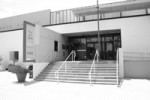The gallery next door

For everyone who isn’t traveling to far away destinations this summer, there are plenty of entertaining things to do locally. One has to look no further than downtown to find museums, galleries, a historic movie theater and plenty of restaurants and bars. While there is plenty to choose from, one of the best places to visit is the Tampa Museum of Art.
Built in 1979, the museum has been attracting crowds for almost 30 years through innovative exhibitions and events. Besides an extensive permanent collection of Greek and Roman antiquities, the museum also offers changing exhibitions. The new exhibitions on display are part of the Rubell Family Collection, which is one of the leading contemporary art collections in the world.
The Rubell family began collecting art in 1964 with the rule that for every $100 of income earned, $25 would be spent on art. Far from their humble beginnings, the Rubell Family Collection now includes pieces from artists such as Keith Haring and Paul McCarthy.
The exhibitions on display as a result of the generosity of the Rubell family are Eberhard Havekost 1996-2006: Paintings from the Rubell Family Collection, Memorials of Identity: New Media from the Rubell Family Collection and Purvis Young: Painted Protests.
Eberhard Havekost is a German artist whose work is largely media-based. Havekost scans all forms of media – magazines, film, television, the Internet and even travel brochures – for photographs and images that can be used for subject matter. These images are then altered digitally by stretching, enlarging, cropping and other techniques and then painted onto canvas.According to Mark Coetzee, director of the Rubell Family Collection, Havekost’s paintings feature iconography familiar to all urban and suburban dwellers – bland modernist structures, featureless landscapes and images of actual and impending violence.
One violent image is “Totale Idylle (Total Idyll).” Despite the black sky depicted, the image is bright and full of primary colors. The setting is a suburban neighborhood with identical houses and bright green lawns. There are two people in the painting – one with a gun to the back of the other’s head. The potential victim is cringing – his head and shoulders squeezed together. The tension within the scene can be felt strongly by the viewer.
The piece demonstrates Havekost’s interest in using painting as a form of social commentary and evokes memories of current events, especially the recent massacre at Virginia Tech. However, the piece is even more unsettling by choosing a suburban neighborhood for the setting. It reminds viewers that safety is an illusion, crime can happen anywhere and appearances can be deadly.
This interest in crime and violence is also present in Havekost’s “Zensur (Censorship),” a series of 25 photographs of dead bodies, revolutionaries and machine guns. Although Havekost’s style effectively combines photography and painting, it is a refreshing change to be able to view his photographs in their true form instead of painted.
Not all of Eberhard Havekost’s work contains violence, however. Several of his pieces resemble images that can be found in advertisements, which makes sense considering the images originated in the media. For example, “Boulevard 2” is a painting that showcases the torso of a woman in a red bikini. Her tanned body glistens in the sun, while the sand and ocean can be seen behind her. She is headless – only her body is of interest. The image is bland, sexist and it resembles the majority of advertisements.
Memorials of Identity: New Media from the Rubell Family Collection features the work of seven international artists: William Kentridge, Sigalit Landau, Jun Nguyen-Hatsushiba, Sven Pahlsson, Anri Sala, Fiona Tan and Artur Zmijewski. The artists use film and video to explore issues of identity.
William Kentridge is a South African artist whose pieces explore apartheid and its consequences. His drawings, mainly black and white but sometimes interspersed with blue and red, are used to create stop-motion films. The exhibit is showing three of his films: Ubu Tells the Truth, Felix in Exile and History of the Main Complaint.
Lastly, the Tampa Museum of Art is exhibiting Purvis Young: Painted Protests. Unlike the previous two exhibits, which are on loan from the Rubell family, the 91 Purvis Young paintings were given as a gift to the Tampa Museum of Art from the Rubells. Young is a self-taught artist who paints scenes reminiscent of the inner city neighborhood where he grew up. Instead of painting on canvas, Young paints on any surface he can find, from doors to discarded slabs of wood. This choice of material not only lends uniqueness to his pieces, but also raises questions regarding poverty in America. Some of his pieces are reminiscent of Jean-Michel Basquiat, while others show similarities to Emil Nolde’s crude, simplified forms.
Besides changing exhibits, the Tampa Museum of Art hosts several events to entertain art lovers – the most popular of which is Art After Dark. Held the third Friday of each month from 8 to 11 p.m., Art After Dark is an after-hours program that combines art, live music, performances and libations. The events are usually themed, but the next Art After Dark is a celebration of the one-year anniversary of the event. The event is May 18 and 19 and will feature sculpture, painting, fashion design, live music and performance art. Art After Dark usually features local artists and musicians, so attending the event is a great way to support the local scene. Art After Dark is free for members and $10 for nonmembers.
For art during the day, the museum holds numerous other events such as Art for Lunch, Sunday Sessions with USF and Art Lover’s Tea.
The Tampa Museum of Art is located at 600 N. Ashley Drive. The exhibitions mentioned run through July 8, and student admission is $3 or free for members. However, there are times when the museum is free to enter – call for details and hours of operation.







